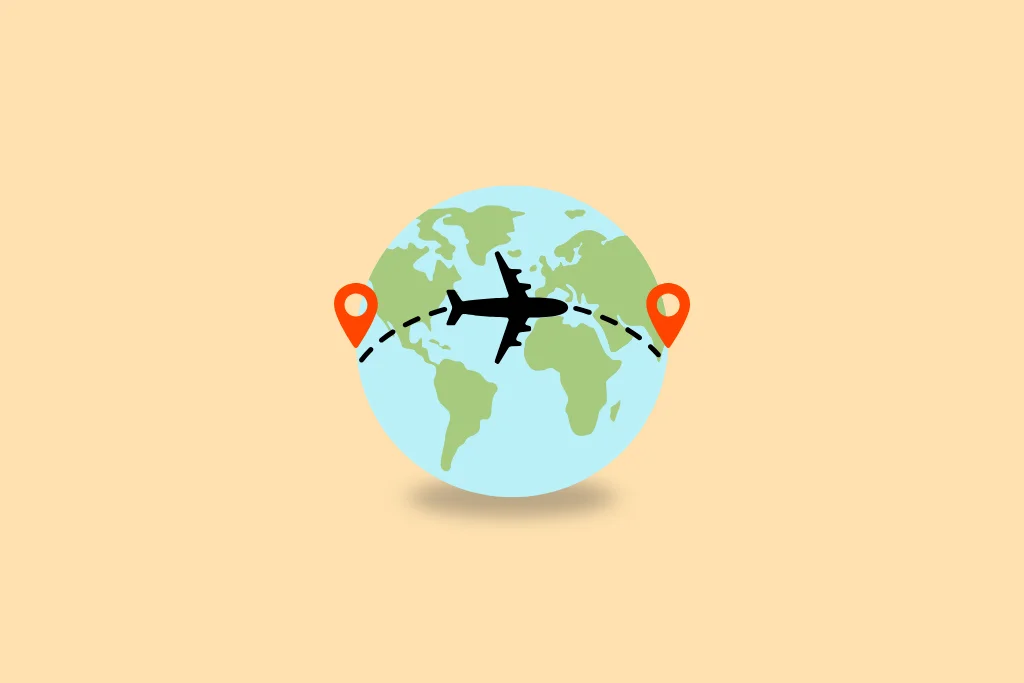🌏 I just read this AWESOME book. It’s a fictional (but highly historically accurate) tale of the history of the Pitcairn Islands, one of the most remote and fascinating places in the world. Check it out if you love travel, history, and a well-written book.

Good morning and welcome back to Daily Drop, the Polaroid picture of newsletters. Because today, we’re going to SHAKE IT UP. 📸
I know, I’m so clever.
By popular demand, today’s content is geared specifically toward infrequent travelers:

✈️ What I'd do if I could only travel once per year
One of the biggest pieces of feedback I get from readers is that most people can’t travel like I do (which is, to put it mildly, totally fair).
And while I think the travel tips I discover and share from my adventures can apply to most people, I thought it’d be helpful to give some specific tips to those who have more traditional jobs and schedules, and limited time to travel in a given year.

If I only had 10 vacation days a year, here’s how I’d approach planning, scheduling, hacking, credit cards, points, and miles for a single epic trip.
1. Scheduling
Obviously, the main hurdle of this scenario is planning an awesome trip with limited time to be away from home.
Personally, I don’t mind having a day (or multiple days) in the air, overnight layovers, etc.
But when you’re working with limited time, we want to minimize transit time and maximize time on the ground.
A few ways you can do this are:
Take advantage of weekends
Take advantage of holidays
Fly when you’d be sleeping
Ideally, combine those all together
For example, let’s say you want to take a big international trip in 2024 but only have 10 vacation days. You could plan around Memorial Day and three different weekends to book a 17 or 18-day trip abroad.
The pink below represents the potential trip length, the stars mark vacation days, and the 27th is Memorial Day. 👇

If you wanted to go to Europe, you could fly out after work on a Friday night, be on the ground first thing in the morning on Saturday, and come back almost three weeks later having only used ten vacation days and a holiday.
That’s enough time to go pretty much anywhere in the world. Or… as you’ll see… enough time to go all the way around the world… 😎
2. Credit cards
Another piece of frequent feedback that I get is as follows:
“I understand that there are tons of great credit cards for frequent travelers. But what if I only travel once or twice a year? Unlimited lounge access, travel credits, and elite status aren’t worth me paying hundreds of dollars per year if I only use them once.”
I agree completely. Honestly, even if I can justify a high annual fee by using credits, perks, etc., it’s probably not worth the time and effort if I’m only going to use those perks once.
That’s why I’d recommend a low-annual-fee card setup that earns meaningful rewards - and a lot of them.
Specifically, I’d get the following two cards:
This card with a low annual fee that earns transferrable points. Transfer partners include Hyatt, United, Flying Blue, Aeroplan, Virgin Atlantic, JetBlue, and more.
This card with NO annual fee. If you have card number one, this card will also earn the same transferrable points (read more about how this works here) and earns 1.5x points on EVERYTHING.
Between these two credit cards, you can earn valuable points on your spending year after year while only paying a combined annual fee of under $100 total. In fact, because of the various earning rates of the cards, you’ll be earning MORE than one point per dollar on every single purchase.
Plus, by simply signing up for them and meeting the minimum spending requirements, you’ll end up with a whopping 150,000 UR Points from the welcome offers (which are subject to change, FYI).
Now let’s look at how far those points could take you in May of 2024.
3. Travel hacking
Yay, finally the fun part. 😎
Now that you’ve maximized your days off and found a low-fee, low-stress way to earn points and miles every year, let’s look at ways we can use those points for a sweet trip.
As I mentioned earlier, flying out to Europe after work on a Friday is a great option, since most of your time in the air is when you’d normally be sleeping.
For example, you could book this flight on KLM from Boston to Frankfurt, Germany for just 20,000 Flying Blue miles, which you can transfer from UR Points.

Once in Frankfurt, you could transfer 10,500 points to Hyatt and book three nights at this Hyatt Hotel, which only costs 3,500 points per night.

Now let’s say you wanted to get a little farther east in Europe…
You could hop over to Prague on a quick, cheap Lufthansa flight for only around $100. In Europe, flights can often be so cheap that it’s not really worth using points at all! 🤷♂️
Plus, the late-night, one-hour flight doesn’t eat into your activity time in either city too much.

Once in Prague, you could transfer more points to Hyatt and book a few nights at the Lindner Hotel, which also only costs 3,500 points per night.
I stayed here a couple of months ago and it was lovely, especially for only 3,500 points per night.

Now you have a nice, picturesque spot to enjoy the scenery of Prague and demolish some beers and pork knuckles until you’re so full you can’t walk (No? Just me?).
But at this point, you’ll probably be sick of Europe. So let’s GTFO.
Personally, I’d take advantage of this crazy deal from Flying Blue and fly from Prague to Osaka, Japan for just 25,000 miles.
Simply transfer your UR points to Flying Blue and book her, just like the first flight of the trip.

Now, we’re about a week into the trip and have spent about 66,000 points. Not too shabby.
But surely we don’t have enough points left to book a hotel in Japan AND get all the way home… right?
Actually, that’s wrong. And don’t call me Shirley. 😡
As it turns out, there are lots of cheap hotels in Japan, and they’re perfectly comfortable 99% of the time. Oh, and you can book many of them right in this bank’s portal, using your hard-earned UR Points.
For example, in the bank’s portal, you could book this hotel in a great location in Kyoto (which is right up the road from Osaka) for just $51 per night.

A 6-night stay would run you $336 in total.
But since you can redeem your UR Points for 1.25 cents each by holding this card, you could book your whole 6-night stay for just 26,880 points in the portal.
💡 By the way, if all of this talk about transferring points and portal booking is confusing to you, check out our guide to UR Points, which explains all of these topics in more detail.
Now let’s tally up all of the points so far:
Flight to Europe: 20,000 Flying Blue miles
Hotel in Frankfurt: 10,500 Hyatt points (3 nights)
Hotel in Prague: 10,500 Hyatt points (3 nights)
Flight to Japan: 25,000 Flying Blue miles
Hotel in Japan: 26,880 UR Points (6 nights)
Total: 92,880 points
Now, your trip has lasted 14 nights (12 in hotels, two overnight flights), so it’s time to think about getting home to the good ‘ol US of A. 🇺🇸
But we’re running a little low on points… 😬
Is there any transfer partner that can get us all the way from Osaka back to our starting point of Boston?
Well, yes, my friend, there is.
If you transfer another 57,000 points to Aeroplan (another transfer partner from UR Points), you can book this itinerary from Osaka straight back home:

And that would bring our total points spent up to… drum roll, please… 149,780 points. You just booked a full around-the-world trip for $95 in total credit card fees, ten vacation days, and under 150k points.
And you’d still have a full day to recover from the jet lag before you go back to work. 😉

And guess what?
This example is actually pretty conservative, as it doesn’t take into account any of the following:
Transfer bonuses: Generally, you can save another 20-30% on Flying Blue flights because of frequent transfer bonuses.
Promo Rewards: Although we paid 20,000 miles for the flight to Europe, KLM and Air France will often sell them for just 15,000 miles or less. With a 30% transfer bonus and a Promo Reward, that 20,000-point flight could end up costing you less than 12,000 miles.
Points from spending: To get the signup bonuses I mentioned, you need to spend money on your cards, all of which earns you even more points.
Of course, the taxes and fees, transit, that short Lufthansa flight, and other expenses will cost you a few hundred bucks, so we shouldn’t think of this as a “free” trip.
Still, I think this is a good example of how you can book an interesting, wide-spanning trip around the world with limited travel hacking, credit cards, or vacation days.
It’s a low-cost, low-effort way to play the travel hacking game for your one big moment every year.
I hope you enjoyed this section today!
I’m thinking about making this a recurring theme in Daily Drop where I give travel hacking advice for people who travel in a much different way than I do, and how I’d personally approach those scenarios.
So tell me…
Which one of the following sections do you want to see the most?Feel free to leave other suggestions as well! |
Only Email Recipients can participate in polls. |
Now that I’ve eaten up your precious morning coffee time, I’ll let you go.
See you tomorrow, my beautiful friends ❤️










